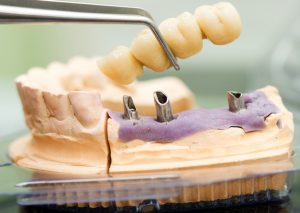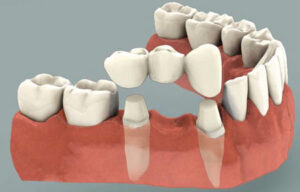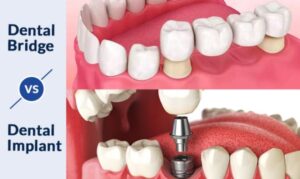
Missing teeth aren’t just a cosmetic issue; they can also impact your oral health. Dental bridges serve as a comprehensive solution, offering both functional benefits and aesthetic improvements. But what exactly are dental bridges, and how do they work? Let’s dive into the world of dentistry: what is a bridge? We’ll explore their ins and outs, and learn more about this effective dental solution.
Key Takeaways
- Dental bridges are a permanent replacement for missing teeth, restoring their functionality and aesthetically enhancing the smile.
- There are four types of dental bridges (traditional, cantilever, Maryland and implant-supported) which vary in features depending on patient needs.
- Costs can range from $700 to over $10,000 with insurance typically covering up to 50%.
Understanding Dental Bridges
A dental bridge is a restorative solution designed to address the issue of missing teeth. Its primary function is to replace the missing teeth, restoring both functionality and aesthetics, and providing support to the surrounding teeth. Dental bridges are especially beneficial for individuals who have undergone tooth loss or substantial decay. However, they are typically not placed in individuals younger than 17 or 18, except in certain cases.
Dental bridges come with numerous benefits. They address changes caused by missing teeth, restore a person’s bite, and improve their dental health. With good oral hygiene and regular dental visits, a dental bridge can provide an effective, long-lasting solution. Before pursuing this treatment, patients need to comprehend the costs and benefits. Once they get used to them, dental bridges should feel akin to natural teeth.
Components of a Dental Bridge
A dental bridge comprises several key components:
- Pontics: These serve as the artificial teeth to replace the missing ones.
- Abutment teeth: These are the natural teeth or implants providing support to the bridge.
- Crowns: These are placed over the abutment teeth to ensure the stability of the bridge.
Getting the abutment teeth ready for a dental bridge involves the dentist taking off a bit of the enamel and dentin. This method makes space for the crowns, which will serve as a supportive structure for the bridge. Such preparation lays the groundwork for the dental bridge’s installation.
How Dental Bridges Function
Dental bridges function by substituting the absent tooth with a permanent replacement and securing the bridge firmly in place with the help of the surrounding teeth. This mechanism restores the function of missing teeth, making eating and speaking easier.
Apart from their functional benefits, dental bridges also play a significant role in enhancing aesthetics. They restore the natural look of a complete smile, improving facial aesthetics, and instilling confidence. Additionally, they aid in preserving the proper alignment of teeth, thereby enhancing the bite.
Types of Dental Bridges

There are four primary classifications of dental bridges:
- Traditional
- Cantilever
- Maryland
- Implant-supported
Each type has its unique features, and the choice depends on the patient’s specific needs, the number of missing teeth, and the condition of the remaining teeth.
The construction of a traditional dental bridge involves the placement of dental crowns on both ends with artificial teeth in between. This type, known as a resin bonded bridge, is commonly used by bonding the crowns to the natural teeth on either side of the gap.
A cantilever dental bridge, on the other hand, only has a crown on one end and relies on a single adjacent tooth for support, making it a suitable option for a missing tooth.
Maryland Dental Bridges stand out due to their attachment method, featuring metal wings on the sides that are bonded to the back of adjacent teeth, eliminating the requirement for crowns or implants.
Traditional Dental Bridges
A traditional dental bridge is comprised of a false tooth or teeth supported by dental crowns that are bonded to the abutment teeth. These bridges are commonly constructed using materials such as Porcelain-Fused-to-Metal (PFM) bridges, gold, alloys, and porcelain.
The process for installing traditional dental bridges includes:
- Assessment
- Teeth preparation
- Temporary bridge placement
- Permanent bridge placement
Despite involving several steps, the process is typically straightforward and can be completed in a few dental visits.
With appropriate maintenance, a traditional dental bridge can last anywhere from 10 to 15 years, and potentially up to 20 years.
Cantilever Dental Bridges
In a cantilever dental bridge:
- The pontic, or artificial tooth, is supported and secured by a dental crown that is bonded to just one abutment tooth.
- This type of bridge is most appropriate when there is only one adjacent tooth available to support the bridge.
- It is commonly utilized for replacing missing front teeth and is recommended for the anterior region of the mouth, but not for the posterior teeth due to the higher force exerted in that area.
The placement of a cantilever dental bridge involves cementing a crown to one side of the pontic. Unlike traditional bridges, the tooth on the other side of the gap is not utilized for support and therefore does not necessitate a crown.
Maryland Dental Bridges
The Maryland dental bridge is a specific type of dental bridge that incorporates a framework made of either metal or porcelain. This framework consists of a pontic with wings, which is then bonded onto the backs of the abutment teeth.
Maryland dental bridges provide numerous benefits, including:
- Restoring chewing function by replacing missing teeth
- Enhancing appearance
- Improving oral health
- Offering a reversible solution with minimal preparation of adjacent teeth.
Implant-Supported Dental Bridges
An implant-supported bridge is a specialized dental bridge that requires a dental implant placement in the jawbone, providing exceptional strength and stability in comparison to alternative implant supported bridges options.
Dental implants, serving as artificial tooth roots, are surgically inserted into the jawbone during the placement procedure. Subsequently, osseointegration occurs, signifying the biological bonding of the artificial roots with the natural jawbone. This treatment process generally takes several months from initiation to completion.
The Dental Bridge Procedure
Obtaining a dental bridge typically entails undergoing a series of at least two procedures. The initial step is the consultation where the dentist conducts a comprehensive examination of the patient’s oral health to assess their suitability for the procedure. This involves reviewing the patient’s medical history, performing a thorough examination, and potentially conducting x-rays and imaging.
Following the consultation, the dentist prepares the abutment teeth by removing a portion of the enamel and dentin to make room for the crowns that will provide support for the bridge. Then, impressions of the shaped teeth are taken and forwarded to the dental laboratory. Acquiring dental impressions for bridge creation necessitates the employment of accurate materials and the execution of correct clinical techniques.
Initial Consultation
The initial consultation for a dental bridge involves a comprehensive oral examination by the dentist to evaluate the suitability for the procedure. This appointment also allows for open discussion of patient concerns and any inquiries regarding the dental bridge process.
The dentist assesses the patient’s oral health, addresses their concerns, and evaluates the suitability of a dental bridge as a treatment option. This assessment also takes into account the patient’s overall dental history and any underlying oral health issues that may need to be resolved before proceeding with bridge placement.
Tooth Preparation
The reshaping of neighboring teeth through enamel removal, which is fundamental to dental bridges, prepares the tooth. This method paves the way for a crown or false tooth (pontic) installation, which supports the bridge.
The process of tooth preparation for a dental bridge involves scraping off some tooth enamel to make room for the crown. This step is essential to ensure the accurate fit and positioning of the bridge.
Dental Impressions and Bridge Fabrication
Dental impressions serve a key purpose in offering a comprehensive plan for the lab production of a dental bridge. They capture the unique contours of the patient’s teeth, ensuring a custom fit and seamless integration with the natural teeth.
Acquiring dental impressions for bridge creation necessitates the employment of accurate materials and the execution of correct clinical techniques. The dentist will create casts of your teeth and mouth to guarantee a precise impression.
Final Bridge Placement
The final placement of a dental bridge involves the following steps:
- Replacing the temporary bridge with the permanent one
- Ensuring a proper fit
- Making final adjustments and checks for comfort and suitability
- Cementing the bridge in place
Possible complications during the final placement of a dental bridge may involve:
- Suboptimal fit resulting in gum recession and infection
- Decay at the anchoring teeth
- Framework or porcelain fracture
- Mobility or loss of abutment teeth
- The bridge becoming loose or dislodged
Dental Bridge Maintenance and Care
 To guarantee the durability of a dental bridge, you should:
To guarantee the durability of a dental bridge, you should:
- Uphold good oral hygiene
- Seek professional cleanings biannually
- Use a mild toothpaste free from hydrogen peroxide, baking soda, and other severe elements to prevent potential harm to dental bridges.
In addition to regular professional cleanings, it’s recommended to brush twice a day and floss daily. This practice helps uphold good oral hygiene and ensure the longevity of the bridge. Also, it’s advisable to avoid consuming acidic beverages such as cola, wine, and black tea, as they have the potential to harm the enamel of the teeth.
Oral Hygiene Practices
Maintaining the integrity of a dental bridge is dependent on good oral hygiene practices. This includes using a soft-bristled toothbrush or an electric toothbrush with soft bristles to gently brush the bridge and adjacent teeth. Additionally, incorporating a water flosser or an interdental brush can further improve cleaning under and around the bridge.
It’s also recommended to brush twice a day and floss daily. This practice helps to maintain good oral hygiene and ensure the longevity of the bridge.
Foods to Avoid
To safeguard your dental bridge, it’s advisable to avoid hard and sticky foods. These can get trapped under the bridge, causing discomfort, or physically damage the bridge’s structure. Also, restricting sugar intake is crucial, as excessive sugar can lead to tooth decay and cavities in the teeth supporting the dental bridge, compromising the bridge’s overall structural integrity.
In addition, it’s advisable to avoid consuming acidic beverages such as cola, wine, and black tea. These drinks can harm the enamel of the teeth, pose a risk to the abutment teeth, and lead to discoloration and staining.
Dental Bridge Costs and Insurance
The price of a dental bridge can greatly fluctuate, spanning from $700 to several thousands of dollars per tooth. On average, a bridge might cost roughly $3500, and possibly up to $5000. More intricate cases necessitating multiple implants and bridges could surpass $10,000.
Dental insurance usually subsidizes up to 50% of the expense for dental bridges. Nonetheless, the exact coverage depends on your unique insurance plan. It’s crucial to examine your plan’s details to comprehend the cost fraction you should anticipate to cover out-of-pocket.
Factors Affecting Cost
Several factors can sway the price of a dental bridge. These include the type of bridge, its design, the materials used, and any additional procedures that may be necessary for its placement.
Location or geographic region can also impact the cost of dental bridges. Factors such as higher costs for health services and varying expenses for materials and types of bridges can contribute to the overall cost discrepancy.
Insurance Coverage
Specific insurance providers like Humana might offer coverage for dental bridges. However, it’s important to review the specific details of your individual insurance plan as coverage can vary significantly.
The typical out-of-pocket expenses for dental bridges with insurance can vary from approximately $1,000 to $2,500. Insurance plans generally provide coverage for around 40% to 50% of the costs of a dental bridge, with annual spending limits typically ranging from $1,000 to $1,500.
Alternatives to Dental Bridges
Though dental bridges are a favored solution for missing teeth, other alternatives are worth considering. Dental implants offer increased durability and a more natural aesthetic compared to dental bridges. However, they also typically involve a higher initial investment.
Partial dentures are another alternative to dental bridges. They offer cost-effectiveness, easy removal for cleaning, and the flexibility to be adjusted or replaced as necessary. However, they may provide less stability and feel less natural compared to fixed dental bridges.
Summary
In conclusion, dental bridges offer a versatile solution to replace missing teeth, restore functionality, and enhance aesthetics. With various types available, thorough professional consultation is key to choosing the right dental bridge for your specific needs. Proper care and maintenance can ensure the longevity of the dental bridge, making it a long-term investment in your oral health.
Frequently Asked Questions
How long does a dental bridge last?
A dental bridge typically lasts five to 15 years, with some lasting even longer if cared for properly. These bridges are sometimes referred to as permanent bridges.
What is the disadvantage of dental bridge?
The major disadvantage of a dental bridge is that it requires the preparation of the anchor teeth, which may not always be the most conservative approach.
Is a dental bridge painful?
Dental bridge procedures are typically painless, as your dentist will apply local anesthetic to numb the area. Therefore, patients need not worry about potential discomfort.
What are the components of a traditional dental bridge?
A traditional dental bridge consists of a false tooth or teeth, connected to dental crowns that are bonded to the abutment teeth.
What is the difference between a traditional bridge and a cantilever bridge?
A traditional bridge has crowns on both ends for support, while a cantilever bridge only has a crown on one end and relies on a single adjacent tooth for support.




